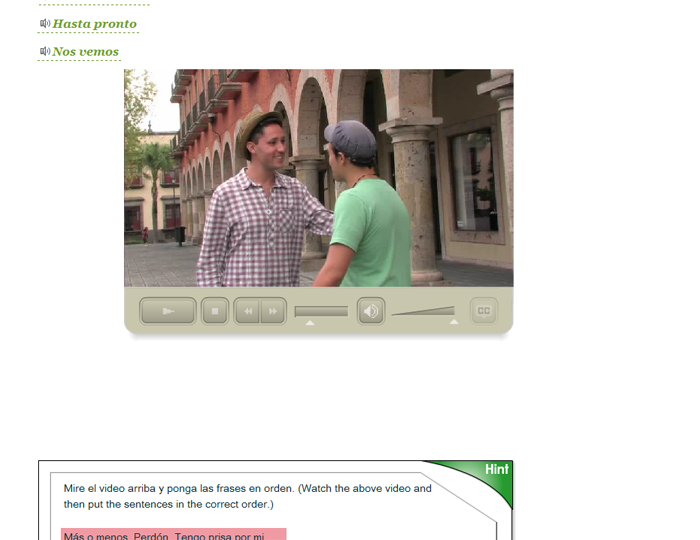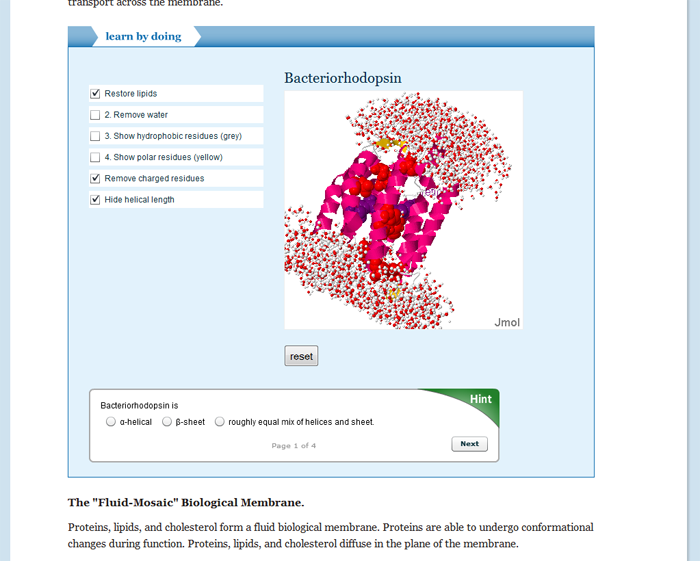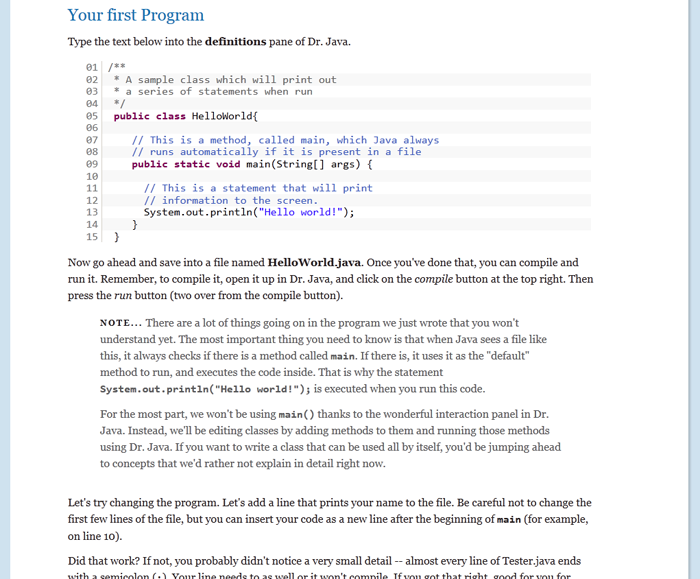Learn spanish in a media-rich and interactive environment, driven by video that was shot on-site in Guadalajara, Mexico.
Spanish 1 — Independent Learners
$10
- Description
- What students will learn
- Learning objectives by module
- Course assessments, activities, and outline
- Other course details
- System requirements
Description
Spanish 1 is media-rich and interactive, driven by video that was shot on-site in Guadalajara, Mexico. This course is available for low-cost use by instructor-led classes of enrolled students, and can be adapted for a hybrid delivery system or solely distance delivery. Please note: the Open & Free version of Spanish 1 contains just a sample of the content, and not the full course.
To successfully use this course, you should be a motivated student with a sincere desire to learn the Spanish language and about cultures in the Spanish-speaking world, and be comfortable with computer technologies. The time commitment will typically average eight hours per week.
Topics Covered:
- Introductions and Greetings
- Physical and Personality Descriptions
- Popular Hobbies
- School and Studies
- Food and Restaurants
- Home and Family
This course is part of a two-semester sequence (Spanish 1 & 2). Each course is divided into twelve thematic lessons, with ample opportunity for reentry and review. Completing both courses will require two semesters. Instructors can select, reorder or eliminate materials when using the course. Each lesson contains short video components to contextualize the material. Segments of the video are then replayed in a variety of interactive activities and tutors. All videos were filmed in Mexico, incorporating authentic speech, cultural references, and gestures.
The beginning of each lesson is always a set sequence, from recognition of language, through explicit learning of grammar and pronunciation, to written and spoken production. After this ordered beginning, many activities are offered to the student in which the language learned is used in understanding new texts, sounds or videos, or in creative production. Lesson tests and exams are available to students enrolled in instructor-led courses. The Learning Dashboard allows for at-a-glance evaluation by instructors of student progress based on each lesson’s learning objectives.
What students will learn
By the end of this course, students will learn to:
- recognize key elements of spoken exchanges.
- become automatic with words and phrases that will be the foundation for their Spanish
- comprehend and write written words and expressions.
- identify correct grammatical forms.
- Speak about themselves (introductions, family, origins, age, personality, work, activities)
Learning objectives by module
Spanish I Learning Objectives list
Lesson 1
In this lesson you will learn:
- to introduce yourself and your friends
- to describe yourself and your friends and family
- to talk about your classroom and basic activities of the class
You will also discover:
- a basic history of the Spanish language
- how people meet and greet each other in Latin America and Spain
Lesson 2
In this lesson you will learn:
- to talk about some of your daily activities
- to talk about what you like and don’t like
You will also discover:
- information about many other languages spoken in Latin America and Spain
- some of the arts and artists of Guatemala, as well as about the country itself
Lesson 3
In this lesson you will learn:
- to discuss your studies and jobs
- to talk more about daily activities
- to tell time and explain what time and day you have class or do certain activities
You will also discover:
- what university life is like for students in Latin America
- some interesting things about professional life in Latin America and Spain
- how the education system functions in Mexico
Lesson 4:
In this lesson you will learn:
- how to explain more of your activities and hobbies
- how to talk about your family members
- more ways that you can talk about things you or other people have
You will also discover:
- about archaeological sites in Perú
- about family life in Spain
Lesson 5
In this lesson you will learn:
- to make plans and talk about the near future
- to talk about important dates and times of the year
- to talk about the weather
You will also discover:
- information about the Dominican Republic
- different concepts of time in the Spanish-speaking world
- diverse climatic conditions in Latin America
Lesson 6
In this lesson you will learn:
- how to talk about the location of people and things
- how to discuss actions that are in progress
- how to express how you are feeling, both physically and emotionally
You will also discover:
- interesting parts of Puerto Rico
- the tradition of celebrating the 15th birthday as an important milestone
Lesson 7
In this lesson you will learn:
- to talk more about some of your likes and dislikes
- to discuss your hobbies and pastimes
- to conjugate many more verbs!
You will also discover:
- about Colombia, and Gabriel García Márquez
- the impact of telenovelas in the Spanish-speaking world
Lesson 8
In this lesson you will acquire:
- more ways to discuss your daily activities and habits
- differences between por and para
- reflexive verbs, or actions you do to yourself
You will also learn about:
- Cuba, and in particular about women in the film industry
- the Cuban artist Wilfredo Lam
Lesson 9
In this lesson you will learn:
- more nuanced ways to talk about your preferences and your emotions
- how to make comparisons between people, places, and things
- to discuss your obligations and duties
You will also read about:
- Ecuador and its biodiversity
- The famous architect, Gaudí, and his influence in Barcelona.
- Contemporary architecture in Mexico
Lesson 10
In this lesson you will learn:
- to discuss actions in the past
- about traditions and celebrations
You will also explore:
- Latino populations in the United States
- the diversity of the Spanish language as it is spoken throughout the world
Lesson 11
In this lesson you will acquire:
- more preterite conjugations
- many words and expression to talk about clothing and shopping
You will also read about:
- Uruguay and some of the linguistic variations in the Río Plate region.
- the Rastro market in Madrid
- the tradition of bargaining, depending on where you shop
Lesson 12
In this lesson, you will learn:
- more about verbs, and some contrasts between different tenses
- to discuss food and nutrition, an essential every-day topic!
Additionally, you will discover:
- some of the rich culinary traditions of Venezuela, and about the cultural value of sharing meals and conversation.
Course assessments, activities, and outline
Coming soon.
Other course details
System requirements
OLI system requirements, regardless of course:
- internet access
- an operating system that supports the latest browser update
- the latest browser update (Chrome recommended; Firefox, Safari supported; Edge and Internet Explorer are supported but not recommended)
- pop-ups enabled
- cookies enabled
Some courses include exercises with exceptions to these requirements, such as technology that cannot be used on mobile devices.
This course’s system requirements:
- none





